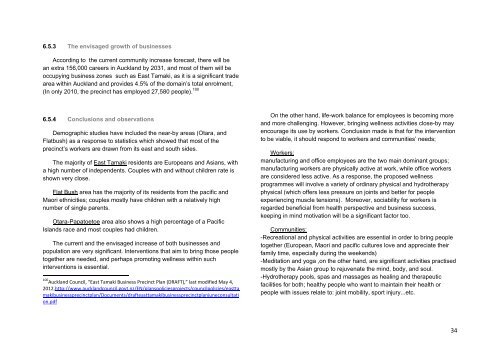Noor Abid_2016-02-19
You also want an ePaper? Increase the reach of your titles
YUMPU automatically turns print PDFs into web optimized ePapers that Google loves.
6.5.3 The envisaged growth of businesses<br />
According to the current community increase forecast, there will be<br />
an extra 156,000 careers in Auckland by 2031, and most of them will be<br />
occupying business zones such as East Tamaki, as it is a significant trade<br />
area within Auckland and provides 4.5% of the domain’s total enrolment,<br />
(In only 2010, the precinct has employed 27,580 people). 100<br />
6.5.4 Conclusions and observations<br />
Demographic studies have included the near-by areas (Otara, and<br />
Flatbush) as a response to statistics which showed that most of the<br />
precinct’s workers are drawn from its east and south sides.<br />
The majority of East Tamaki residents are Europeans and Asians, with<br />
a high number of independents. Couples with and without children rate is<br />
shown very close.<br />
Flat Bush area has the majority of its residents from the pacific and<br />
Maori ethnicities; couples mostly have children with a relatively high<br />
number of single parents.<br />
Otara-Papatoetoe area also shows a high percentage of a Pacific<br />
Islands race and most couples had children.<br />
The current and the envisaged increase of both businesses and<br />
population are very significant. Interventions that aim to bring those people<br />
together are needed, and perhaps promoting wellness within such<br />
interventions is essential.<br />
100 Auckland Council, “East Tamaki Business Precinct Plan (DRAFT),” last modified May 4,<br />
2012,http://www.aucklandcouncil.govt.nz/EN/planspoliciesprojects/councilpolicies/eastta<br />
makibusinessprecinctplan/Documents/drafteasttamakibusinessprecinctplanjuneconsultati<br />
on.pdf<br />
On the other hand, life-work balance for employees is becoming more<br />
and more challenging. However, bringing wellness activities close-by may<br />
encourage its use by workers. Conclusion made is that for the intervention<br />
to be viable, it should respond to workers and communities’ needs;<br />
Workers:<br />
manufacturing and office employees are the two main dominant groups;<br />
manufacturing workers are physically active at work, while office workers<br />
are considered less active. As a response, the proposed wellness<br />
programmes will involve a variety of ordinary physical and hydrotherapy<br />
physical (which offers less pressure on joints and better for people<br />
experiencing muscle tensions). Moreover, sociability for workers is<br />
regarded beneficial from health perspective and business success,<br />
keeping in mind motivation will be a significant factor too.<br />
Communities:<br />
-Recreational and physical activities are essential in order to bring people<br />
together (European, Maori and pacific cultures love and appreciate their<br />
family time, especially during the weekends)<br />
-Meditation and yoga ,on the other hand, are significant activities practised<br />
mostly by the Asian group to rejuvenate the mind, body, and soul.<br />
-Hydrotherapy pools, spas and massages as healing and therapeutic<br />
facilities for both; healthy people who want to maintain their health or<br />
people with issues relate to: joint mobility, sport injury...etc.<br />
34



